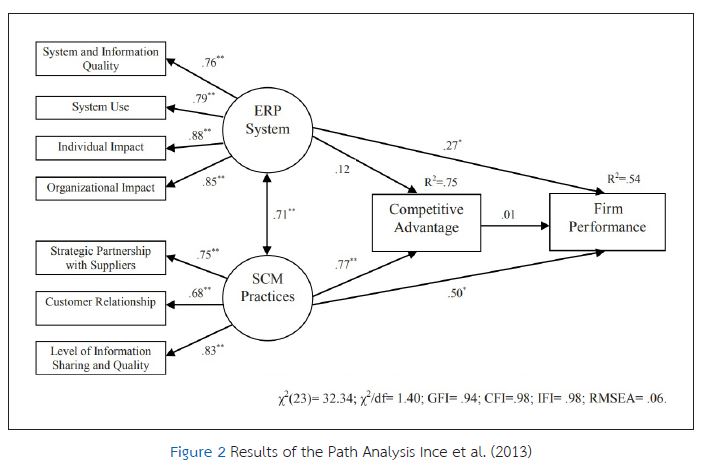The Influence of a Cloud-Based Enterprise Resource Planning System and Organization IT Strategy on Business Operational Efficiency through the Warehouse Management Process: a Case Study of the Automotive Parts Industry in Thailand
Keywords:
ERP Cloud Base system, Information Technology strategy, Warehouse Management, Operational EfficiencyAbstract
This research aimed to study the impact on the operational efficiency. Independent variables were the utilizing of ERP Cloud Base system and information technology strategy, while warehouse management was the mediating variable. Dependent variable was the operational efficiency. Sample consisted of 215 people involved in the organization's information system, including executives, information technology executives, information technology managers, and information operation officers, selected from the automotive parts industry via stratified random sampling method. Data were analyzed using the Structural Equation Model (SEM), which the model structure was applied to test the hypothetical model. Results indicated that the model had proportion and all hypotheses regression were accepted with p-value < 0.05. The results of the fit and consistency test were consistent with the empirical data and sub-components of the structural model,
Research results showed that using ERP Cloud Base system and information technology strategy had direct impact on the operational efficiency. In addition, indirect impact was also shown in warehouse management, indicating that ERP Cloud Base system and information technology strategy implementation should combine with appropriate warehouse management in order to further improve the organization’s operational efficiency.
References
Anđelković, A., & Radosavljević, M. (2018). Improving order-picking process through implementation of warehouse management system. Strategic Management-International Journal of Strategic Management and Decision Support Systems in Strategic Management, 23(1).https://doi.org/10.5937/StraMan1801003A
Atieh, A. M., Kaylani, H., Al-Abdallat, Y., Qaderi, A., Ghoul, L., Jaradat, L., & Hdairis, I. (2016). Performance improvement of inventory management system processes by an automated warehouse management system. Procedia CIRP, 41, 568-572. https://doi.org/10.1016/j.procir.2015.12.122
Badewi, A., Shehab, E., Zeng, J., & Mohamad, M. (2018). ERP benefits capability framework: orchestration theory perspective. Business Process Management Journal, 24(1), 266-294. https://doi.org/10.1108/BPMJ-11-2015-0162
Baruffaldi, G., Accorsi, R., & Manzini, R. (2019). Warehouse management system customization and information availability in 3pl companies: A decision-support tool. Industrial management & data systems, 119(2), 251-273. https://doi.org/10.1108/IMDS-01-2018-0033
Batini, C., & Scannapieco, M. (2016). Data and information quality. Cham, Switzerland: Springer International Publishing, 63. https://doi.org/10.1007/978-3-319-24106-7
Certo, S. C., & Certo, S. T. (2019). Modern management: Concepts and skills: Pearson.https://doi.org/10.5465/AMBPP.2019.15546abstract
Chantruprakakul, A., Lata, P., & Silpcharu, T. (2023). Factors affecting the development of Thai auto parts manufacturing industry for export. Journal of Namibian Studies: History Politics Culture, 34, 1853-1873.
Chopra, R., Sawant, L., Kodi, D., & Terkar, R. (2022). Utilization of ERP systems in manufacturing industry for productivity improvement. Materials today: proceedings, 62, 1238-1245.https://doi.org/10.1016/j.matpr.2022.04.529
Cronbach, L. J. (1951). Coefficient alpha and the internal structure of tests. psychometrika, 16(3), 297-334.https://doi.org/10.1007/BF02310555
Eampoonga, I., & Leelasantitham, A. (2023). Overall Success Factors Affecting the Performances of Hybrid Cloud ERP: A Case Study of Automobile Industries in Thailand. Journal of Mobile Multimedia, 1153-1194.https://doi.org/10.13052/jmm1550-4646.1953
Faber, N., De Koster, M., & Smidts, A. (2013). Organizing warehouse management. International Journal of Operations & Production Management, 33(9), 1230-1256. https://doi.org/10.1108/IJOPM-12-2011-0471
Faber, N., & Van de Velde, S. L. (2002). Linking warehouse complexity to warehouse planning and control structure: an exploratory study of the use of warehouse management information systems. International Journal of Physical Distribution & Logistics Management, 32(5), 381-395.https://doi.org/10.1108/09600030210434161
Fontana, M. E., & Nepomuceno, V. S. (2017). Multi-criteria approach for products classification and their storage location assignment. The international journal of advanced manufacturing technology, 88, 3205-3216. https://doi.org/10.1007/s00170-016-9040-3
Foster Jr, S. T., & Franz, C. R. (1999). User involvement during information systems development: a comparison of analyst and user perceptions of system acceptance. Journal of Engineering and Technology Management, 16(3-4), 329-348. https://doi.org/10.1016/S0923-4748(99)00014-4
Gomes, J., De Weerd-Nederhof, P. C., Pearson, A., & Fisscher, O. A. (2001). Senior management support in the new product development process. Creativity and Innovation Management, 10(4), 234-242.https://doi.org/10.1111/1467-8691.00226
Hair, J. F., Ringle, C. M., & Sarstedt, M. (2013). Partial least squares structural equation modeling: Rigorous applications, better results and higher acceptance. Long range planning, 46(1-2), 1-12.https://doi.org/10.1016/j.lrp.2013.01.001
Hair Jr, J. F., Hult, G. T. M., Ringle, C. M., Sarstedt, M., Danks, N. P., & Ray, S. (2021). Partial least squares structural equation modeling (PLS-SEM) using R: A workbook: Springer Nature.https://doi.org/10.1007/978-3-030-80519-7
He, J., & King, W. R. (2008). The role of user participation in information systems development: Implications from a meta-analysis. Journal of management information systems, 25(1), 301-331.https://doi.org/10.2753/MIS0742-1222250111
Henderson, J. C., & Venkatraman, H. (1999). Strategic alignment: Leveraging information technology for transforming organizations. IBM systems journal, 38(2.3), 472-484.https://doi.org/10.1147/SJ.1999.5387096
Ince, H., Imamoglu, S. Z., Keskin, H., Akgun, A., & Efe, M. N. (2013). The impact of ERP systems and supply chain management practices on firm performance: case of Turkish companies. Procedia-Social and Behavioral Sciences, 99, 1124-1133. https://doi.org/10.1016/j.sbspro.2013.10.586
Jeong, K. Y., & Phillips, D. T. (2001). Operational efficiency and effectiveness measurement. International Journal of Operations & Production Management, 21(11), 1404-1416.https://doi.org/10.1108/EUM0000000006223
Joshi, A., Kale, S., Chandel, S., & Pal, D. K. (2015). Likert scale: Explored and explained. British journal of applied science & technology, 7(4), 396-403.https://doi.org/10.9734/BJAST/2015/14975
Lam, C., Choy, K., & Chung, S. H. (2010). Framework to measure the performance of warehouse operations efficiency. Paper presented at the 2010 8th IEEE International Conference on Industrial Informatics. https://doi.org/10.1109/INDIN.2010.5549667
Lee, J.-N. (2006). Outsourcing alignment with business strategy and firm performance. Communications of the Association for Information Systems, 17(1), 49. https://doi.org/10.17705/1CAIS.01749
Lockett, A., Thompson, S., & Morgenstern, U. (2009). The development of the resource‐based view of the firm: A critical appraisal. International journal of management reviews, 11(1), 9-28.https://doi.org/10.1111/j.1468-2370.2008.00252.x
Madhani, P. M. (2010). Resource based view (RBV) of competitive advantage: an overview. Resource based view: concepts and practices, Pankaj Madhani, ed, 3-22.
Matende, S., & Ogao, P. (2013). Enterprise resource planning (ERP) system implementation: a case for user participation. Procedia Technology, 9, 518-526. https://doi.org/10.1016/j.protcy.2013.12.058
Mishra, A., Dutta, P., Jayasankar, S., Jain, P., & Mathiyazhagan, K. (2023). A review of reverse logistics and closed-loop supply chains in the perspective of circular economy. Benchmarking: an international journal, 30(3), 975-1020. https://doi.org/10.1108/BIJ-11-2021-0669
Muslmani, B. K., Kazakzeh, S., Ayoubi, E., & Aljawarneh, S. (2018). Reducing integration complexity of cloud-based ERP systems. Paper presented at the Proceedings of the first international conference on data science, e-learning and information systems. https://doi.org/10.1145/3279996.3280033
Nasamu, I. (2022). Strategies for employees to effect change to improve performance of public organizations: Walden University.
Sarstedt, M., Ringle, C. M., Smith, D., Reams, R., & Hair Jr, J. F. (2014). Partial least squares structural equation modeling (PLS-SEM): A useful tool for family business researchers. Journal of family business strategy, 5(1), 105-115. https://doi.org/10.1016/j.jfbs.2014.01.002
Shatat, A. S., & Shatat, A. S. (2021). Cloud-based ERP systems implementation: major challenges and critical success factors. Journal of Information & Knowledge Management, 20(03), 2150034.https://doi.org/10.1142/S0219649221500349
Srisawat, J., & Jaturat, N. (2016). The Influence of ERP Implementation and Organization IT Strategy on Supply Chain Performance through Logistic Management: a Case Study of Food Industry in Thailand. International Journal of Applied Computer Technology and Information Systems, 6(1), 61-69.
Tansakul, N., Suanmali, S., & Shirahada, K. (2021). The development of supply chain performance index by structural equation model approach: a case of Thai automotive industry. Thammasat University.
Weng, K.-F., Hung, C.-T., Hsieh, P.-T., Li, M.-L., Chen, G.-W., Kung, Y.-A., . . . Lin, J.-Y. (2014). A cytoplasmic RNA virus generates functional viral small RNAs and regulates viral IRES activity in mammalian cells. Nucleic acids research, 42(20), 12789-12805. https://doi.org/10.1093/nar/gku952
Wilson, J., Hair, C., Knight, R., Catto-Smith, A., Bell, S., Kamm, M., . . . Connell, W. (2010). High incidence of inflammatory bowel disease in Australia: a prospective population-based Australian incidence study. Inflammatory bowel diseases, 16(9), 1550-1556. https://doi.org/10.1002/ibd.21209
Yeh, J.-Y., & Lin, C.-Y. ERP Strategy and a Firm's Contextual Dimensions: A Multiple Case Study.

Downloads
Published
How to Cite
Issue
Section
License
Copyright (c) 2024 NIDA Business School, National Institute of Development Administration

This work is licensed under a Creative Commons Attribution-NonCommercial-NoDerivatives 4.0 International License.


